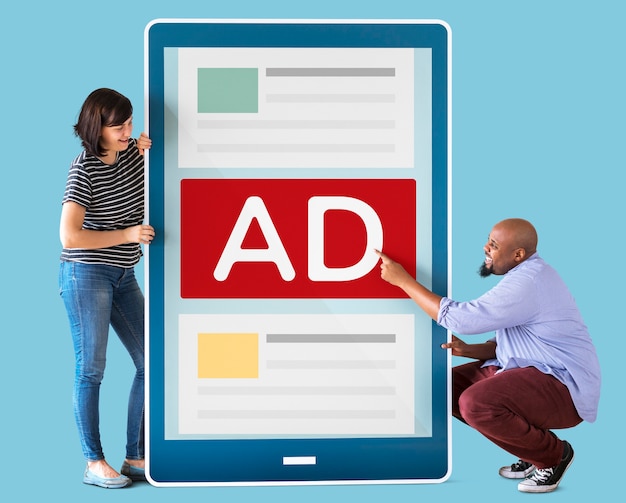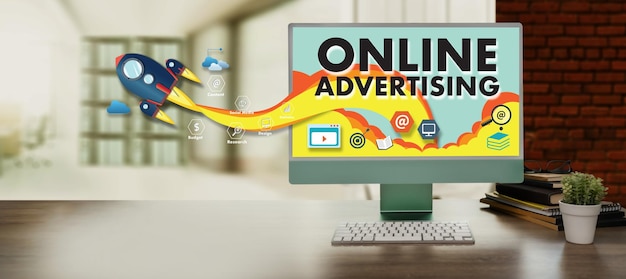The Evolution Of Programmatic Advertising: Revolutionizing Digital Marketing
5 Mins Read
Published on: 07 November 2023
Last Updated on: 08 November 2024

toc impalement
Get ready for an exciting journey through the history of programmatic advertising. We’ll start by looking back at the early days of online advertising, like the introduction of the banner ad in 1994, which marked a major turning point in advertising.
This journey isn’t just about technology and ads; it also explores various marketing strategies. So, come along as we dive into the past, explore the present, and look ahead to the future of digital advertising.
The Past: How It All Started

It all started with the very banner we mentioned above. It appeared on October 27, 1994, on HotWired.com, the name of the electronic version of Wired magazine, then the only one of its kind.
During those nascent days of the World Wide Web, HotWired.com stood as a lone beacon of digital publishing. In a world where the internet was still an uncharted territory, this electronic version of Wired magazine was a trailblazer, offering readers a glimpse into the future of media consumption.
The inaugural digital advertising campaign, orchestrated by the Euro RSCG agency, marked a watershed moment in advertising history. It featured a diverse roster of clients, including heavyweights like AT&T, Volvo, MCI, and others. This campaign was a bold experiment into uncharted territory, as no one at the time truly grasped what advertising on the Internet should entail.
Consider the context of the mid-1990s: the online world was in its infancy, inhabited by a mere two million users, and internet connections crawled at a snail’s pace, capped at a meager 24.4 Kbps, and the first graphical browser Mosaic was not even a year old.
Since then, online advertising has traveled many steps on its way to becoming what we know it to be today. While it’s no longer as revolutionary a concept as it was in 1994, online advertising never ceases to wow users, and we’ll talk about that next.
The Present: How It Goes

Recently, digital advertising has changed a lot because of programmatic platforms. These smart tools have made it easier for brands to place ads on digital platforms automatically. Programmatic advertising is now a crucial part of modern marketing, simplifying how marketers reach their audience online.
The growth trajectory of programmatic advertising is nothing short of remarkable. Projections indicate that by the year 2026, global spending on programmatic advertising will surpass a staggering 725 billion dollars.
The digital marketing revolution highlights the global influence this technology has exerted on the marketing sector. An increasing number of brands are acknowledging the potential of programmatic ads to effectively reach and engage their desired audiences.
Some factors make digital advertising so special and popular: the possibility of personalization, omnichannel strategy, and transparency.
Personalization
With the vast amount of data available on the Internet, brands can create customized and relevant content that resonates with each individual client. A customized approach enhances not only the user experience but also boosts the effectiveness of advertising campaigns, leading to increased engagement and conversions.
Omnichannel Strategy

This programmatic strategy emphasizes brand experiences across multiple channels and devices, ensuring that consumers can interact with a brand in a consistent and non-intrusive manner.
By leveraging the power of omnichannel, advertisers can maintain a strong and unified brand presence, regardless of whether the consumer is engaging through a website, a mobile app, social media, or other platforms. This multifaceted approach enhances brand recognition and fosters long-lasting customer relationships.
Transparency
Transparency is another key facet that contributes to the appeal of online ads. Unlike traditional advertising, where measurement and tracking can be challenging, online ads provide marketers with comprehensive data and analytics.
This openness empowers brands to continuously monitor the performance of their campaigns in real-time, modify their strategies, and allocate resources with greater precision. It encourages accountability and enables businesses to make informed, data-driven decisions, ultimately enhancing the overall programmatic advertising impact.
Today, a strong programmatic advertising strategy can decide the fate of a brand, help it find its audience, and increase profits. Advertising is not just about promoting products; it’s a powerful tool that forges connections with the target customers, leading to increased profitability.
By evoking emotions and building brand recognition, advertising creates lasting customer loyalty. In the digital age, data-driven approaches enhance targeting and campaign effectiveness. In essence, advertisement serves as a catalyst for transforming and shaping the destinies of brands, solidifying its role as a fundamental cornerstone within modern marketing.
The Future: Hopes And Concerns

Hopes
Programmatic advertising continues to evolve, and the future is sure to bring many ad tech advancements that we are starting to see today. A prime illustration of this evolution is the pioneering use of artificial intelligence (AI) and machine learning within programmatic ads, particularly in the context of Real-Time Bidding (RTB) auctions.
Moreover, AI and machine learning empower a new level of personalization that was once beyond imagination. These technologies have the capability to analyze data pertaining to user behavior, preferences, and demographic details, enabling advertisers to deliver highly pertinent and customized content to individual users.
This heightened degree of personalization not only enhances engagement but also enriches the overall user experience, leading to increased conversion rates and enhanced campaign performance.
Looking ahead, the future teems with the possibility for more advanced algorithms, more diverse data sources, and enhanced advertising automation. These innovations stand poised to streamline various facets of advertising, including the optimization of creative content and the strategic placement of ads.
Furthermore, the rise of AI-powered chatbots and virtual assistants in customer interactions and engagement strategies is a trend with the potential to exert a significant influence on advertising.
Concerns
One of the primary concerns plaguing programmatic advertising marketers is the impending demise of cookies, a development currently slated for the year 2024. Cookies, those ubiquitous files that have long been the lifeblood of data collection and targeting in the digital advertising realm, are poised to fade into obsolescence.
Using cookies has always been a key part of digital advertising. It helps marketers understand what users like and how they behave online. This information helps create personalized ads that work better and make more money.
Yet, amid the concerns, there exists a glimmer of optimism and a sense of anticipation. The industry is actively exploring alternative avenues for gathering the essential data that cookies once provided. These emerging methods are, in many cases, more robust, privacy-conscious, and attuned to the evolving digital landscape.
Solutions such as first-party data collection, consent-based approaches, and contextual targeting are gaining traction and offer promising pathways toward maintaining effective targeting strategies.
To Wrap It Up
Programmatic advertising has come a long way from its initial banner days. While it faces its share of challenges, it continues to evolve, introducing new mechanisms for user-friendly targeting. The future holds promising prospects as integrated AI technologies are expected to take the lead.
These innovations will optimize budgets, enhance media trading, and even facilitate creative generation for advertisers. This evolution points to campaigns becoming increasingly effective and less time-consuming, ushering in a new era of efficiency in the advertising industry.
Additional:


















Comments Are Closed For This Article